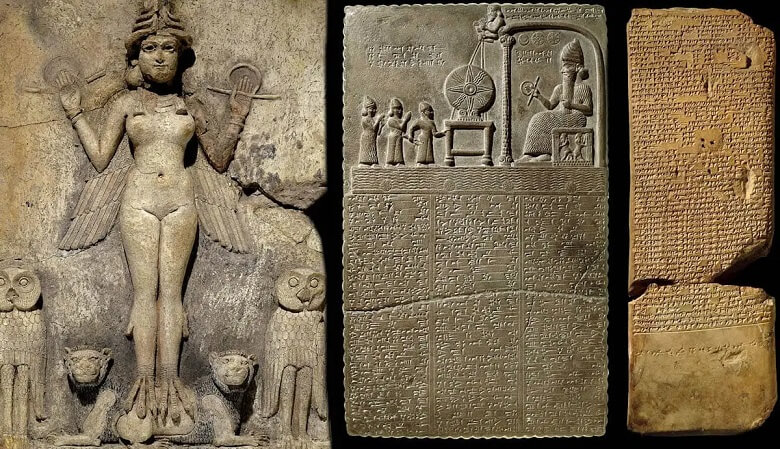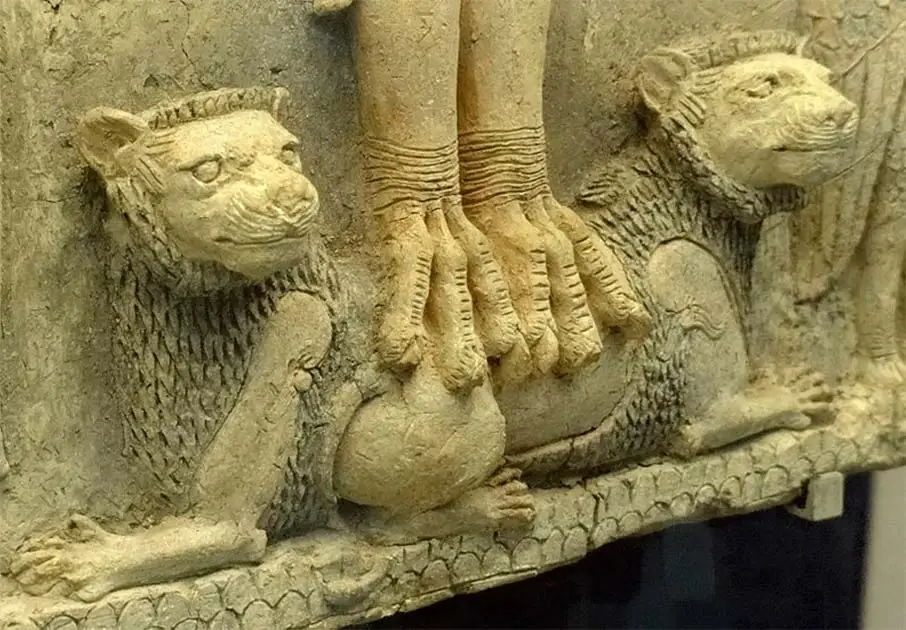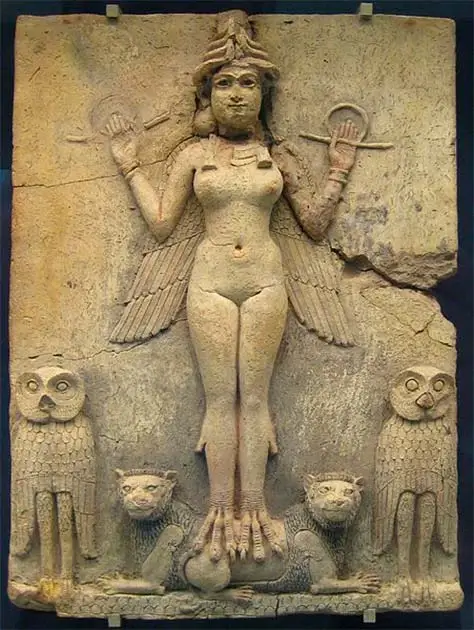
Who Is The Babylonian Queen of The Night?
Ishtar was one of the most prominent Mesopotamian Goddesses. A dualistic deity Babylon with a variety of roles, Ishtar defied conventional categories and her influence extended beyond humanity’s first civilizations.
By: Bipin Dimri | Historic Mysteries
On display in the British Museum, amongst the artefacts of a hundred ancient and lost civilizations, sits is small terracotta relief display known as the Burney Relief. It is small, measuring around 19.4 inches in height and 14.5 inches in width (50 cm by 36 cm), but it is what it depicts that makes it so precious.
On the relief is depicted a naked woman with wings, flanked by owls. She is standing on the back of two lions. It was made during the era of Hammurabi (1792-1750 BCE) in Babylonia.
Dubbed the “Queen of the Night”, the figure is surprisingly well preserved. She apparently was painted and decorated with ochre and other paints at some point, but now all that remains is the naked stone.
Who is this figure from the Old Babylonian period? Why is she portrayed like this, and why did she come to be known as the Queen of the Night?
A Goddess
Firstly, most agree that the Queen of the Night is almost certainly a goddess. She is wearing a deity’s horned headdress, for a start.
Following that, she also holds the rod-and-ring symbol in her hands, which is considered sacred. Along with the wings on her back, the lady also has her legs tapered to the bird’s talons, which are seen to have gripped onto the lion’s back.

The rod and ring appear repeatedly, mostly described as the god’s instruments of measurement and survey. They are also symbols of kingship, as they are given to the king by a god or goddess to lay out a temple.
In the Epic of Gilgamesh we hear such a story. The goddess Innana gives these items, named mikku and pukku to Gilgamesh as a reward. But he used it very unwisely and ended up causing grief to all women of Uruk. As a result, he lost them and fell into the underworld.
In honesty, the terms pukku and mikku have not been translated yet, but they probably resemble the same rod and ring, which are god’s instruments and symbols of kingship. In this way it is helpful to see a depiction of something referenced in the text, to provide context.
At the base of the plaque is a motif that represents the mountains and indicates that the woman is standing on high ground. Scholars have differing interpretations of the reasons for this, and indeed which goddess exactly the Queen of the Night could be representing.
Experts believe that this plaque could be the replication of the goddess Ishtar, who was a Mesopotamian goddess of sexual love & war. The experts also thought she might be the goddess Ereshkigal or the demoness Lilitu, Adam’s first wife from the Bible.
The experts considered it a statue of Ereshkigal because of the downward pointing wings on the plaque. If it was a depiction of Inanna, then the wings should have been ordinarily spread upwards. The idea was to represent the sky and underworld in this significance.
However there might be an explanation which allows for Inanna. In the story of Inanna’s descent to the underworld, the goddess was forced to take off all her ornaments while she was passing through the realm of her sister. Thus, it may be that this depiction is Inanna at the end of this story, with downwards wings representing this.

We are also not helped by lacking a clear provenance for the piece. The Burney Relief named after a British antiquities and art dealer, Sydney Burney. The artefact is said to have been brought to London by some Lebanese or Syrian dealer in the 1930s, and we do not even know where it was originally found.
In 1936, the plaque was offered first to the British Museum. However they refused to buy it, citing these problems with provenance and that the artefact was not archaeological but instead stolen from Iraq, an accusation some might find ironic. As a result of this rejection the Burney Relief was passed on from one private collector to another in the following few decades.
The last of the collectors, Sakamoto Goro finally sold the plaque to the British Museum for $1.9 million in 2004.
A Mystery
So, shorn of useful provenance can we determine anything about this plaque? There is no consensus on who created her, but the plaque was probably intended for an Old Babylonian shrine. She has been dated back to around the 19th or 18th century BC and was probably created during the reign of Hammurabi.
Initially painted, over time the Burney Relief has lost its colours. But as per scientific research on it, the experts determined that there was red ochre applied all across her body. Gypsum was also maybe used as a white pigment for specific areas of the plaque, but this may have formed naturally from salts in groundwater.
However, there is help in understanding this plaque from elsewhere: the Queen of the Night has a twin, a nearly identical relief in the Louvre Museum, albeit in a worse state of preservation.
But it still has a clear depiction of the nude female character with wings and talons. One critical difference between these two plaques was that the one in Louvre was standing on two horned animals, who might be gazelles or goats, whereas the one in British Museum was standing on two lions. Why? We don’t know.

Not just that, but the same goddess also appeared in variants of various small, crude or molded plaques in Babylonia between 1850 and 1750 BCE. Thermoluminescence tests have confirmed that the Queen of the Night relief was made right in the middle of this dating.
So who was she? Some believe she is a goddess, a recognizable member of the Babylonian pantheon. Others consider her a mythological figure, perhaps not a goddess at all but something more akin to the Greek furies or gorgons.
She might be the Queen of Sky, Inanna or the Queen of Underworld, Ereshkigal. She might be the demoness Lilitu, or just a monster. But what the Queen of the Night certainly offers is a window into an ancient, lost civilization, and their beliefs in gods and monsters.
* * *
NEXT UP!
Gobekli Tepe: The World’s First Temple?
Six miles from Urfa, an ancient city in south-eastern Turkey, Klaus Schmidt has made one of the most startling archaeological discoveries of our time: massive carved stones about 11,000 years old, crafted and arranged by prehistoric people who had not yet developed metal tools or even pottery. The megaliths predate Stonehenge by some 6,000 years.
The place is called Gobekli Tepe, and Schmidt, a German archaeologist who has been working here more than a decade, is convinced it’s the site of the world’s oldest temple.
* * *
READ MORE: This Ancient Maya City Was Hidden In The Jungle For More Than 1,000 Years
Read more on Babylon’s History: What Caused The Historic Fall of Sumer?
Enjoyed it? Please take a moment to show your support for Collective Spark.
We’d love to hear from you! If you have a comment about this article or if you have a tip for a future Collective Spark Story please let us know below in the comment section.
